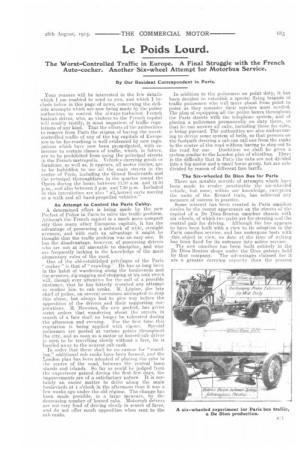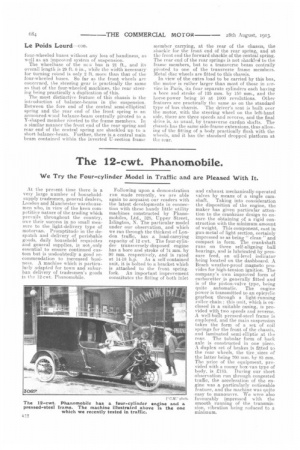Le Poids Lourd.
Page 7

Page 8

If you've noticed an error in this article please click here to report it so we can fix it.
The Worst-Controlled Traffic in Europe. A Final Struggle with the French Auto-cocher. Another Six-wheel Attempt for Motorbus Service.
By Our Resident Correspondent in Paris.
Your reaaers will be interested in the few details which I am enabled to send to you, and which I include below in this page of news, concerning the deftjute attempts which are now being made by the police authorities to control the always-turbulent French taxicab driver, who, as visitors to the French capital will readily testify, is most impatient of traffic regulations of any kind. That the efforts of the authorities to remove from Paris the stigma, of having the worstcontrolled traffic of any of the big capitals of Europe are to be far-reaching is well evidenced by new regulations which have now been promulgated, with reference to certain classes of traffic, which, in future, are to be prohibited from using the principal streets in the French metropolis. 'Vehicles carrying goods or furniture, as well as, it appears, all motor lorries, are to be forbidden to use all the main streets in the centre of Paris, including the Grand Boulevards and the principal thoroughfares in the quarter round the Opera, during the hours between 11.30 a.m. and 12.30 p.m., and also between 2 p.m. and 7.30 p.m. Included in this interdiction are also " all, horsed carts moving at a walk and all hand-propelled vehicles."
An Attempt to Control the Paris Cabby.
A determined effort is being made by the new Prefect of Police in Paris to solve the traffic problem. Although the French capital is a much more compact city than many other European capitals, it has the advantage of possessing a. network a wide, straight avenues, and with such an advantage it might be thought that the traffic problem was an easy one. It has the disadvantage, however, of possessing drivers who are not at all amenable to discipline, and who are frequently lacking in the knowledge of the most elementary rulesof the road.
One of the old-established privileges of the Paris " cocher "is that of " crawling." He has so long been in the habit of wandering along the boulevards and the avenues, zig-zagging and stopping at his own sweet will, though ever attentive for the call of a possible customer, that he has bitterly resented any attempt to confine him to cab ranks. M. Lepine, the late chief of notice, on several occasions attempted to mile this abuse, but always had to give way before the opposition of the drivers and their supporting corporations. M. Hennion, the new prefect, has given strict orders that wandering about the streets in search of a fare shall no longer be tolerated during the afternoon and evening. For the first time this regulation is being applied with vigour.. Special policemen are posted at various points throughout the city, and as soon as a, motor or horsed-cab driver is seen to be travelling slowly without. a fare, he is hustled away to the nearest cab rank.
In order that there shall be no excuse for "crawling," additional cab ranks have been formed, and the London plan has been adopted of placing the cabs in he centre of the road, between the central lamp stands and islands. So far as could be judged from the experience gained during the first few days, the improvements are of a satisfactory nature. It is certainly an easier matter to drive along the main boulevards at 4 o'clock in the afternoon than it was a few weeks ago under the old regime. The change has been made possible, in a large measure, by 11w decreasing number of horsed cabs. Motoreab drivers are not very fond of driving slowly in search of fares, and do not offer much opposition when sent to the cab ranks. In addition to the policemen on point duty, it has been decided to establish a special flying brigade of traffic policemen who will move about from point to point as they consider their services most needed. The plan of equipping all the police boxes throughout the Paris streets with the telephone system, and ot placing a policeman permanently on duty there, so that he can answer all calls, including those for cabs., is being pursued. The authorities are also endeavouring to devise some system of bells, so that persons on the footpath desiring a cab can call one from the ranks in the centre of the road without having to step out to
the road for one. Doubtless we shall be given system similar to the London plan of whistling. There is the difficulty that in Paris the cabs are not divided into a big motor and a small horse group, but are subdivided by reason of different fare tariffs.
The Six-wheeled De Dion Bus for Paris.
There are notable records of attempts which have been made to render • practicable the six-wheeled vehicle, but none, within our knowledge, excepting the. units of the Renard train, has achieved any measure of success in practice.
Some interest has been created in Paris omnibus circles by the recent appearance on the streets of the capital of a De Dion-Bouton omnibus chassis with six wheels, of which two pairs are for steering and the central pair for driving. Although the bus appears to have been built with a view to its adoption in the Paris omnibus service, and has undergone tests with this object in view, no date at the time of writing has been fixed for its entrance into active service.
The new omnibus has been built entirely in the De Dion-Bouton shops uncles. the Gros patents held by that company. The advantages claimed for it are a greater carrying capacity than the press-sit
four-wheeled buses without any loss of handiness, as well as an improved system of suspension.
The wheelbase of the new bus is 21 ft., and its overall length is 29 ft. 6 in., while the width necessary for turning round is only 2 ft. more than that of the four-wheeled buses. So far as the front wheels are concerned, the steering gear is practically the same as that of the four-wheeled machines, the rear steering being practically a duplication of this.
The most distinctive feature of this chassis is the introduction of balance-beams in the suspension. Between the fore end of the central semi-elliptical spring and the rear end of the front spring is an arnioured-wood balance-beam centrally pivoted to a Y-shaped member riveted to the frame members. In a similar manner the front end of the rear spring and rear end of the central spring are shackled up to a short balance-beam. Further, there is a central main beam contained within the inverted U-section frame member carrying, at the rear of the chassis, the shackle for the front end of the rear spring, and at the front end the forward shackle of the central spring. The rear end of the rear springs is not shackled to the frame members, but to a transverse beam centrally pivoted to one of the transverse frame members. Metal disc wheels are fitted to this chassis.
In view of the extra load to be carried by this bus, the motor is rather larger than most of those in service in Paris, its four separate cylinders each having a bore and stroke of 125 mm. by 150 mm., and the horse-power being 50 at 1000 revolutions. Other features are practically the same as on the standard
type of bus chassis. The driver's seat is built over the motor, with the steering wheel on the left-hand side, there are three speeds and reverse, and the final drive is, as usual, by transverse cardan shafts. The chassis has the same side-frame extensions, thus allowing of the fitting of a body, practically flush with the wheels, and it has the standard dropped platform at tlie rear.
























